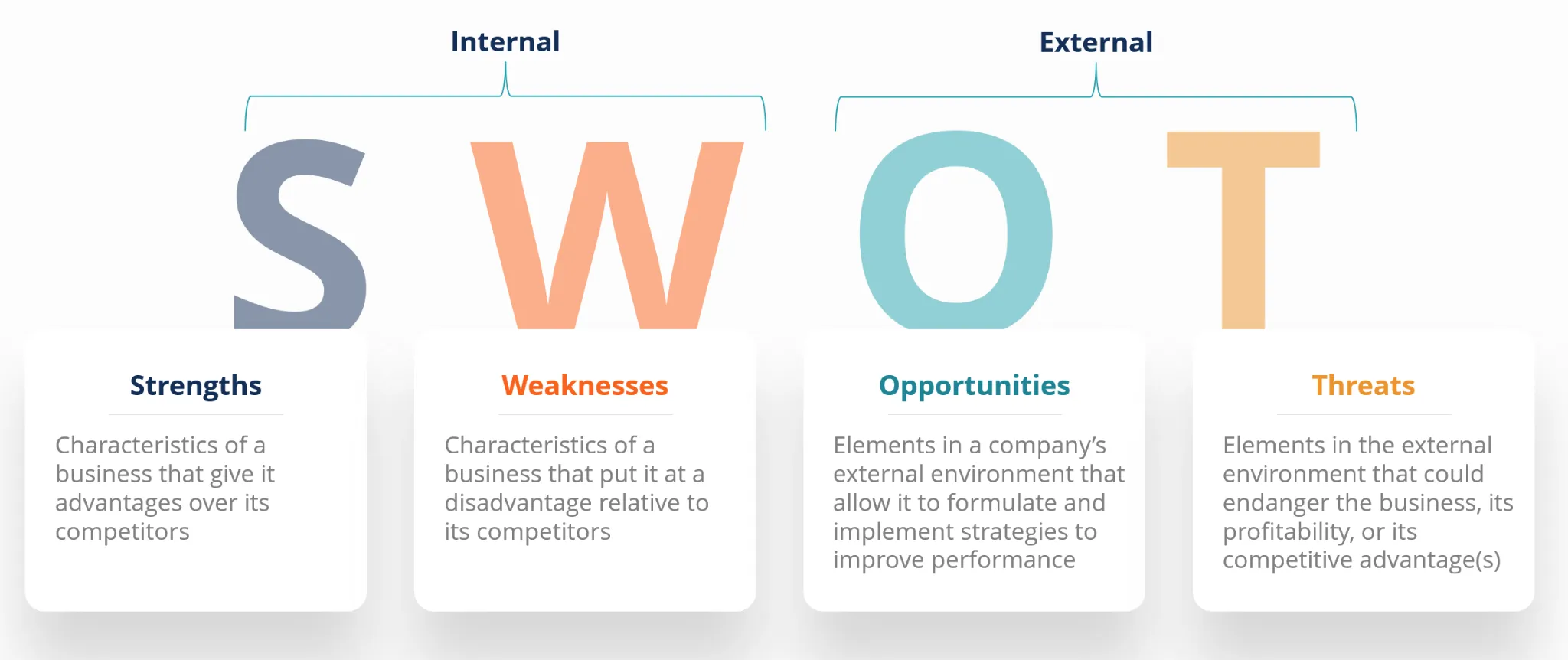SWOT analysis is a strategic planning technique that helps individuals or organizations to identify their strengths, weaknesses, opportunities, and threats. SWOT analysis can be used to evaluate any aspect of an organization, including a new project, a marketing campaign, or an overall business strategy.
SWOT stands for:
Strengths: These are the internal factors that give an organization an advantage over its competitors, such as a strong brand, skilled employees, or proprietary technology.
Weaknesses: These are the internal factors that put an organization at a disadvantage compared to its competitors, such as poor management, outdated technology, or a weak online presence.
Opportunities: These are external factors that an organization can take advantage of to grow its business or improve its operations, such as a new market or a new product category.
Threats: These are external factors that can negatively impact an organization, such as a new competitor entering the market, changes in regulations, or economic downturns.

SWOT analysis can be performed by brainstorming and creating a table with four quadrants representing each of the four factors. Then, individuals or teams can identify and list factors under each quadrant. After the factors have been identified, they can be analyzed and prioritized based on their importance and the impact they have on the organization. SWOT analysis can help individuals or organizations make better-informed decisions and develop effective strategies.
SWOT Analysis Explanation
SWOT analysis is a strategic planning tool used to identify and analyze the internal and external factors that may affect an organization or a specific project. It helps organizations to identify their strengths, weaknesses, opportunities, and threats, and to develop strategies to address them.
Here’s a brief explanation of each component of SWOT analysis:
Strengths: These are the internal attributes of an organization or project that give it an advantage over others. Examples may include skilled employees, a strong brand, proprietary technology, or a loyal customer base.
Weaknesses: These are the internal attributes of an organization or project that may hinder its ability to succeed. Examples may include outdated technology, poor management, lack of funding, or a weak online presence.
Opportunities: These are external factors that may provide new opportunities for an organization or project. Examples may include a new market, a change in consumer behavior, or a new technology that could improve operations.
Threats: These are external factors that may pose a threat to an organization or project. Examples may include new competitors, changing regulations, or economic instability.
SWOT analysis can be used in various contexts, such as evaluating a business’s overall strategy, developing a marketing campaign, or assessing the feasibility of a new product or service. By identifying and analyzing these four components, organizations can develop strategies to maximize their strengths, address their weaknesses, capitalize on opportunities, and mitigate threats.
What is brainstorming in SWOT analysis

Brainstorming in SWOT analysis refers to the process of generating ideas and identifying factors that may fall under each of the four components of SWOT analysis: strengths, weaknesses, opportunities, and threats. It involves a group of individuals coming together to share their ideas and perspectives on the organization or project being analyzed.
During the brainstorming session, participants are encouraged to share their thoughts and ideas freely, without criticism or judgment. This allows for a free flow of ideas, which can lead to the identification of unexpected strengths, weaknesses, opportunities, and threats.
The facilitator of the brainstorming session can use various techniques to encourage participation and engagement, such as open-ended questions, visual aids, or group activities. Once all ideas have been shared, the facilitator can then categorize them into the appropriate quadrant of the SWOT analysis chart.
Brainstorming in SWOT analysis is an important step as it helps to ensure that a comprehensive and diverse set of factors are identified, which can inform the development of effective strategies. It also allows for input from multiple perspectives, which can lead to a more well-rounded analysis.